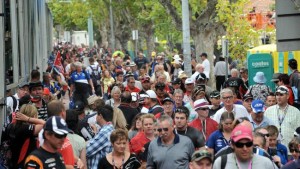Migration tips our population over 24 million
The Australian population was expected to tick over to 24 million at 12.51am on Tuesday, with more than half of that growth driven by new migrants.
The milestone saw Australia match the Chinese city of Shanghai, which houses a similar number of people in less than a thousandth of the space.

The Australian population has now ticked over to 24 million
The Australian Bureau of Statistics (ABS) has mapped the growth in Australia’s population, starting at 5 million people in 1918 and rising to the present day.
The latest population figure of 24 million is drawn from the ABS population clock, which shows a projected rate of population growth based on 12-monthly population estimates.
It anticipates a population increase of one person every 91 seconds, based on known birth, death and migration rates.
Based on these rates Australia will reach a population of 25 million in 2018 and 50 million in 2086. By then the global population will have reached 10.6 billion, according to UN forecasts.
The ABS says migration made up more than half the population increase in the year to July 2015 – at 54 per cent – with birth rates dropping.
That figure is down from 2009, when overseas migration accounted for 66 per cent of the population growth.
The ABS says overseas migration overtook the birth rate as the main source of Australia’s population rate in 2006, two years after the former treasurer Peter Costello urged Australia couples to have “one for the father, one for the mother and one for the country”.
However, the fertility rate was barely boosted by Costello’s plea, showing only a marginal increase from 1.75 in 2004 to 1.8 in 2015 – a lower rate than New Zealand and the United Kingdom and significantly lower than Indonesia – which matches the global fertility rate at 2.5 – but a higher rate than Taiwan, Japan, China and Canada.
But Australia’s population of 24 million falls far short of early predictions. In the 1800s Australia was compared with the US and Melbourne, at the height of the gold rush, was known as ‘the Chicago of the south’.
Many dreamt that Australia might become a new America but the nation lacked the vast fertile plains of the mid-west and the life-giving giant rivers systems of the Mississippi and Missouri.
Yet, Australia remains the only nation to claim an entire continent.
About 28 per cent of Australians today were born overseas. In Britain, that proportion is 12 per cent. In the US it is it is 13 per cent and in Japan just 1 per cent.
According to demographer Bernard Salt by the time Australia reaches 30 million people, America will no longer be the world’s largest economy and India will have more people than China.
“We might even have an Australian Prime Minister or president of Asian, Indian or Middle Eastern heritage,” Mr Salt said.
“By 50 million, the Hong Kong-Shenzhen conurbation, in Perth’s time zone, could well rival New York as the world’s most powerful business city,” he said.
“By 60 million, the baby boom and even the idea of Australia being remote from the centre of global power might all seem like curiosities from a bygone era,” Mr Salt said.
Laurie Nowell
AMES Australia Senior Journalist












